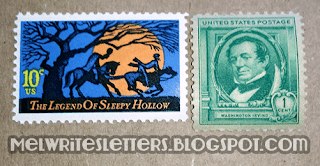I do know that I didn't actually read the real thing until three or four years ago. I think I must have whizzed through it, because I would have told you that, while it was a well-told tale, it was not actually that spooky; however, a second read-through is proving me wrong. This time, I slowed down to let Mr. Irving set the scene, and found that if you remember that all of these things are happening in a creepy place that everyone believes is haunted, it's way better (and more fun).
My goddaughter and I share an old connection related to the book, which is the main reason I started compiling materials to create Sleepy Hollow mail. Writing this post has encouraged me to a) watch the film Sleepy Hollow, which I love, and b) re-read the story. While I do that, here are some recent images of Sleepy Hollow mail, with comments. I'll list all sources at the end.
Stamping on poly envelopes is tough, but not impossible. You need a "sticky," permanent ink (I used StazOn) and some patience, because you need to take it slowly and lift your stamp straight up, then wait for the ink to dry.
These are the three main stamps I have for the Sleepy Hollow theme. I'm on the lookout for more, but some of the usual Halloween favorites can be put into play (bats, jack-o-lanterns), plus anything that would be woodsy - trees, birds, etc.
Whenever possible, I like to send "haunted mail," and this sticker is a great addition (see sources).
I love the lighter gray envelopes for the themed mail because it's already gloomy (white is so stark). On this, I used a fine mist of red spray ink, and medium gray and black stamp pads.
To use the spray ink, get a deep cardboard box and hold the spray bottle as far away from the envelope as you can. Be prepared to try a few times (one pump should do it). This stuff can be pretty nasty if sprayed anywhere else - it was damn hard to get off my fingers - so take care!
While I was working on this post, I starting thinking about how I could make the envelopes even more epic, without spending any extra money. The photo here is the result (so far). I'm still working out the kinks, so follow me on Instagram to see further developments!
I scanned a couple of pages out of an old copy of the book (shown open, above), glued a laser print to an envelope, then hit the edges and random spots with a spray stain (behaves much better than the spray ink, above, but I'd still follow the same steps). I recently found a small Xyron sticker maker in my craft room, so I printed a few images (labeled for reuse) onto photo paper, cut them out using postage-edge scissors, and ran them through the sticker maker. Viola! Faux postage. Inks used were black and dark gray.
Honorable mention, to show off the other Sleepy Hollow Special Delivery sticker. I didn't take a clear picture of it (alone) before mailing. All I used here was the road sign and the sticker, plus the vintage stamps.
And, of course, what started it all. As I mentioned in the Poe envelope post, many of my themes are inspired by the vintage postage stamps I have collected. The Legend of Sleepy Hollow stamp is a favorite (read more about it here) and its natural companion is Mr. Irving's stamp.
Sources
- Free download of the short story from Project Gutenberg. I am a fan of reading original works (someday, I'll get through Frankenstein). This is a slice of Americana that has inspired much of what we know of Halloween, so it's good to know the origins! (Not surprising that Irving impacted my favorite holiday (Halloween), since he also kind of invented Christmas as we know it (repeat link).)
- Interested in getting your own Sleepy Hollow envelopes to send? Contact me via the email link in my profile. I'm working on some ideas and it would help to know if anyone was interested.
- Rubber Stamps
- Horseman: Butter Side Down stamps (unmounted, cling-mounted or wood). They also have an Etsy store, where they sell just the wood-mounted stamps.
- Try Not to Lose Your Head & Road Sign: Impression Obsession - both are cling only. Linking each to the shop where I bought them.
- Bats: from a set by Momenta (gift from a friend)
- Bird stamp: hand-carved gift from a pen pal.
- Headstone: unknown, although I think it's from Rubber Baby Buggy Bumpers, which is out of business. Cemetery stamps are available from other sellers.
- Inks: StazOn black, Ranger Archival in Jet Black & Watering Can (dark gray), Tsukineko's Memento in London Fog (medium gray). Spray ink is from Ranger's Dylusions line in Postbox Red. Spray stain is from Ranger's Distress line in Hickory Smoke.
- Misc:
- May be Haunted sticker: Evil Supply Co. They also made the Sleepy Hollow Special Delivery stickers, but do not offer them in their shop at this time.
- Tape: This is Spinal Tape by Copernicus Toys (Amazon link). I already own this, so I use it, but it is pretty much crap. It doesn't stick to paper well & I have to add a layer of clear tape over it.
- Paper envelopes are from PaperSource (#10 & A9), document box was a re-use, poly envelope was from a bulk purchase.
































